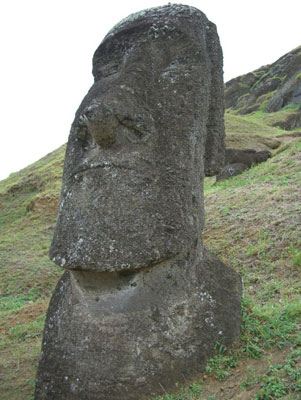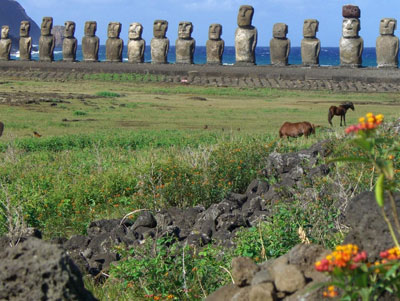Exploring Easter Island
by Nancy Tardy, Henderson, NV
Forget the stories you may have heard about the difficulties of traveling to Easter Island. Though one of the most remote inhabited spots in the world, it is neither hard to reach nor outrageously expensive to visit.
Getting there
Easter Island, or Rapa Nui to the islanders, is called Isla de Pascua by Chileans, who claimed it as a possession in the late 1800s. Lan Airlines (phone 866/435-9526, www.lan.com) flies to the island two to four times weekly from the international airport in Santiago, Chile, and twice weekly from Papeete, Tahiti.
Because of this episodic schedule, most visitors to the island spend three, seven or 10 days on the island. This allows for a more in-depth study of the history and culture of this unique civilization and offers the ability to explore the many petroglyph sites as well as the famous moai and quarries.
I’d also recommend a day or two to enjoy picturesque Anakena Beach, thought to be the original landing site of the Polynesians who settled Easter Island.
The cost of traveling to Easter Island varies widely, depending upon your ability to snag an off-season, weekday or promotional airfare. From gateways in the United States to Santiago, round-trip tickets cost approximately $1,400-$2,000. Round-trip flights from there to Easter Island cost about $800. Though neither is a real bargain, you might find deals on American Airlines (www.aa.com) and LAN websites.
Because of my early-morning flight to Easter Island, I chose to stay one night at the Santiago airport hotel, Hotel Diego de Almagro Aeropuerto, which cost about $125. In a country where breakfast often is not served until 7 or 8, I was amazed to find a full breakfast buffet, including desserts, available at this hotel at 4 a.m. Buses leave for the airport terminal every half hour at no cost to hotel guests.
Island arrival
Five-and-a-half hours of flying west into the uninhabited central South Pacific brought me, in April ’07, to the small airport located about two miles from Hanga Roa, the only village on the island. Take note: all travelers arriving in Chile are assessed an entry fee, currently $100 for US citizens.
Most arriving passengers have lodging reservations, but hotel and visitor information booths are available at the airport for those needing additional help. Taxis to the village, where most of the accommodations are located, are available for about $2, but most hotels and guest houses offer transfers for their guests.
The only hotel not located in town is the newest member of the high-end Chilean resort chain Explora. Rooms cost about $700 per person per night, with full board and all activities included.
Hanga Roa covers more area than you might think a small town of 3,800 people would, but many hotels and guest houses are located near the center of town on Avenida Atamu Tekena, affectionately known as “restaurant row.”
Hotel Orongo (phone/fax 56 322 100 572, www.hotelorongo.com), where I stayed, is noted for its modest prices ($46-$98), and its owner, Raul, will fix gourmet meals for his guests and other travelers with advance notice. Less than a block away, Hotel Tauraa (phone 56 32 210 0463, www.tauraahotel.cl) offers slightly more upscale surroundings and upgraded rooms and amenities, for a slightly higher price, of course.
Hanga Roa has a vast number of restaurants serving residents and travelers. The price and quality varies, but the fresh seafood specials are always a good value. Come with US dollars, as this is primarily a cash economy and dollars are widely accepted.
The local ATM machine takes only MasterCard; visitors wishing to obtain cash from other cards or with travelers’ checks must queue up inside the bank for a lengthy transaction.
Seeing the sights
Most hotel owners offer tours using their own vehicles or local taxis. Alternatively, travelers can independently hike or bike or rent an all-terrain vehicle, car or even a horse to tour the small, 65-square-mile island.
Guidebooks and online websites, such as www.tripadvisor.com and www.southpacific.org/guide/easter-island.html, are helpful for choosing lodging and learning about the historic sites. Most of the island is an open-air museum and designated as a UNESCO World Heritage Site, protected within Rapa Nui National Park.
Of course, the number-one reason for visiting Easter Island is to view the remains of the moai, stylistic statues. While the statues are still steeped in mystery and are eerily evocative of protective guardians, researchers have pieced together much of the puzzle of what, when, how and, especially, why the island natives, called Rapanui, spent their time and used their meager resources to carve and move the moai.
Questions answered
Where did the Rapanui come from and why? Though this has been the subject of debate for years, it is generally agreed that these were Polynesians peopling the Pacific eastward from Tahiti. They used their knowledge of sea currents, weather and navigation by stars to sail their large, outrigger-type canoes filled with food, seeds, animals and families to settle unpopulated islands as the need arose, arriving on Easter Island about AD 400.
Why did they carve the moai? These statues probably were erected not for worship but more likely as veneration of deceased ancestors or leaders.
Most of the moai are found around the edge of the island, facing inland and standing on raised stone platforms called ahu, themselves an architectural phenomenon of intricate stonework.
During the approximately 1,200 years that the islanders carved these statues, the size of the statues increased greatly, possibly an example of an early-day “keeping up with the Joneses.” As the size of each moai increased, so, obviously, did the weight, increasing the need for more laborers to work in the quarries and to haul, by still-undetermined means, the statues from the central island quarry to their final resting place along the shore, often miles away.
Some of the erected moai once stood over 30 feet tall and weighed up to 80 tons. This “bigger is better” notion stripped the island of its natural resources, throwing it into one of the earliest-known ecological collapses. The birds were killed for food, the waters along the shore were overfished and all the trees were felled, possibly to make skids for the statues to slide on and ropes to pull them along their routes.
After having reached a peak population of about 10,000, there were only about 150 inhabitants left by the late 1800s after invasion and disease decimated the population. Even today, the island is largely covered with native grass and short shrubs. The few trees that can be found have been planted in reforestation efforts.
Why were the statues destroyed? Almost 900 moai have been inventoried. Two-thirds remain stuck in their birthplace quarry or along the “road” to their destination, while the remainder have been pulled down by competing Rapanui tribes determined to wreck their opponents’ work while fighting over depleting resources. The moai standing today all have been reerected and are, indeed, sights to behold, vividly reminding us of the fragility of our own ecosystems.
Moai sites
Two quarries on the island supplied the stone for the moai. The main quarry of Rano Raraku is a volcanic site filled with a fairly soft rock of compressed ash called tuff. The Puna Pau quarry provided the red stone used for the carved topknots that dressed some of the moai. Hundreds of partially completed statues lie on the slopes of Rano Raraku awaiting completion, while some finished ones sink into the soil from centuries of neglect.
Of the different sites, Ahu Tongariki, an ahu with 15 moai, is perhaps the most awe inspiring. Restored in the 1990s after a tsunami scattered the statue remnants, it is located on a spectacular oceanfront site. Grazing wild horses give this site a definite nonmuseum feel.
Another site which should not be missed is Anakena, a crescent-shaped beach of white sand that provides an ethereal backdrop to two renovated ahu. One of these contains six moai gazing fixedly away from the beach filled with nearly nude sun worshipers. Three of the Anakena moai sport the red topknot carved from stone at the Puna Pau quarry.
Located a short walk outside of Hanga Roa, the small, self-guided museum depicting Easter Island’s history and culture seems to be almost an afterthought. If you return to town from a visit there by walking along the shore, you are certain to spot the magnificent moai that has been restored with white eyes and black pupils. This moai, at Ahu Ko Te Riku, is the only reerected statue that illustrates the eyes that the Rapanui created from white coral and black obsidian stone.
Whatever your length of stay, your visit to mysterious Easter Island most likely will haunt your memory for a lifetime.





